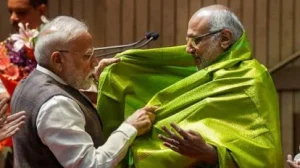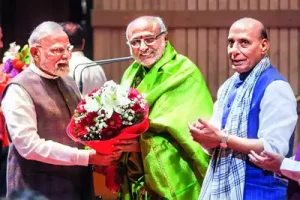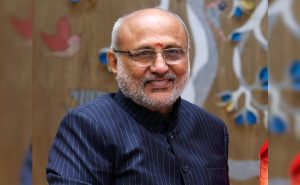New Delhi – Maharashtra Governor CP Radhakrishnan has been elected as India’s next Vice President, securing a commanding victory in the parliamentary election held on September 9, 2025. The 68-year-old NDA candidate will succeed Jagdeep Dhankhar in the prestigious constitutional position, having garnered 452 first preference votes against Opposition candidate Justice B Sudershan Reddy’s 300 votes.
The election results demonstrate CP Radhakrishnan’s broad appeal across party lines, with the veteran BJP leader achieving success through both anticipated NDA support and apparent cross-voting from Opposition ranks. Returning Officer PV Mody announced that while 754 total votes were cast, 15 were declared invalid, leaving 739 valid votes in the final tally.
Narrow Victory Margin Reflects Political Dynamics

Despite the decisive outcome, CP Radhakrishnan’s 150-vote victory margin represents one of the smallest in recent Vice Presidential elections. This contrasts sharply with the 2022 contest where Jagdeep Dhankhar achieved the highest margin in six recent Vice Presidential polls, defeating Margaret Alva with 528 votes against her 182.


The relatively closer margin in CP Radhakrishnan’s victory suggests a more competitive political landscape, though the NDA’s strategic candidate selection appears to have successfully navigated potential challenges. The election results indicate that while the Opposition maintained significant support, they could not prevent cross-party defections that ultimately benefited the ruling alliance’s nominee.
Evidence of Substantial Cross-Voting Emerges


The voting figures reveal clear evidence of cross-voting that worked in CP Radhakrishnan’s favor. The NDA possessed 427 confirmed votes, supplemented by 11 MPs from the supporting YSR Congress Party, theoretically capping their maximum at 438 votes. However, CP Radhakrishnan exceeded this threshold by securing 452 votes, indicating at least 14 additional votes from Opposition members.
This cross-voting pattern suggests that CP Radhakrishnan’s reputation for building relationships across party lines played a crucial role in his electoral success. The BJP had apparently anticipated this possibility when selecting the Tamil Nadu leader as their candidate, banking on his ability to attract support beyond traditional NDA boundaries.
Opposition Unity Questions Surface
The election results have raised questions about Opposition unity, with the Congress claiming solidarity among 315 Opposition MPs while their candidate Justice Reddy received only 300 valid votes. Additionally, the cancellation of 15 votes creates further uncertainty about the actual Opposition vote count and potential internal disagreements.
BJP leader Nishikant Dubey highlighted these discrepancies in social media posts, questioning “which 15 people ran away and voted for us” while making pointed references to electronic versus ballot paper voting systems. The visible vote gaps have provided ammunition for NDA leaders to claim evidence of “deep fissures in Opposition ranks” ahead of upcoming state elections.
Also Read: PM Modi Urges NDA MPs to Champion Bold Swadeshi Movement To Battle Trade War
CP Radhakrishnan’s Political Journey and Credentials


CP Radhakrishnan brings extensive political and administrative experience to the Vice Presidential role. The veteran BJP leader has twice been elected to the Lok Sabha from Coimbatore and previously served as the party’s Tamil Nadu state chief, demonstrating his deep roots in regional politics.
His gubernatorial experience includes serving as Governor of Jharkhand from February 2023 to July 2024, while also holding additional charges as Governor of Telangana and Lieutenant Governor of Puducherry. Colleagues describe CP Radhakrishnan as genial and affable, with a governing philosophy emphasizing cooperation over confrontation.
The selection of CP Radhakrishnan was strategically designed to create potential divisions within Opposition ranks, particularly ahead of crucial state elections in Tamil Nadu. His cross-party relationships and moderate approach appear to have contributed significantly to his electoral success.
Strategic Implications for Regional Politics
CP Radhakrishnan’s victory carries particular significance for South Indian politics, where the BJP has historically faced challenges in expanding its influence. His Tamil Nadu background and established regional connections may help the party’s future electoral prospects in the state.
The successful election of CP Radhakrishnan also demonstrates the NDA’s ability to field candidates who can transcend strict party loyalties, suggesting sophisticated strategic planning for future constitutional positions. His moderate reputation and collaborative approach may prove valuable in managing parliamentary proceedings as Vice President.
Congressional Response and Constitutional Expectations
Congress President Mallikarjun Kharge congratulated CP Radhakrishnan while emphasizing expectations for his Vice Presidential tenure. Kharge’s statement stressed the importance of upholding “highest ethos of Parliamentary traditions” and ensuring “equal space and dignity for the Opposition” without succumbing to ruling party pressures.
The Congress leader’s message reflects Opposition concerns about maintaining constitutional balance and democratic values in parliamentary proceedings. Kharge emphasized that CP Radhakrishnan must “reflect independence, fairness, and strength in safeguarding Democratic values” as the second-highest constitutional office holder.
Future Parliamentary Leadership Under New Vice President
As CP Radhakrishnan prepares to assume the Vice Presidential role, attention focuses on his potential impact on parliamentary proceedings and inter-party relations. His reputation for building consensus and maintaining cordial relationships across political divides may influence the tone and effectiveness of future legislative sessions.
The election of CP Radhakrishnan represents both continuity and change in Indian constitutional leadership, combining experienced political judgment with demonstrated administrative capabilities essential for effective parliamentary governance.

